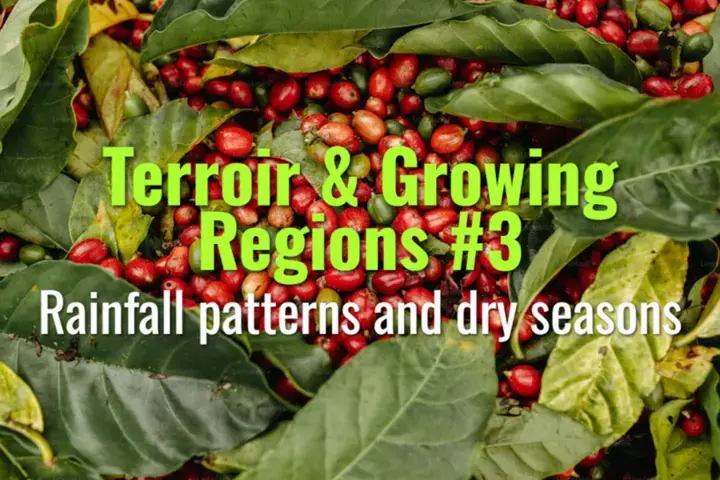Rainfall patterns and dry seasons
This topic explores how rainfall distribution and dry seasons affect coffee flowering, fruit development, and harvest cycles, and why water availability is critical to both yield and quality.
- Coffee Basics Nerds
- 2 min read
Article 3 of 12 in Terroir & Growing Regions/

Rainfall Requirements
- Optimal annual rainfall: 1,200–2,200 mm for Arabica; 1,500–3,000 mm for Robusta.
- Distribution: Evenly spread rainfall supports year-round growth, but distinct wet/dry cycles are crucial for synchronized flowering.
- Seasonality: Many producing regions rely on predictable rainy seasons to trigger key crop stages.
Role of Rainfall in the Coffee Cycle
- Flowering trigger: A dry spell followed by rain stimulates synchronized flowering.
- Fruit development: Steady rainfall during cherry growth ensures proper bean filling.
- Harvest timing: Dry seasons enable sun-drying of cherries, essential for natural and honey processes.
Impact of Dry Seasons
- Benefits:
- Promote uniform flowering when followed by rain.
- Allow natural drying of cherries, enhancing flavor complexity.
- Challenges:
- Prolonged drought can cause flower abortion and fruit drop.
- Extended dryness stresses plants, reducing yield and bean size.
Regional Examples
- Ethiopia: Distinct wet and dry seasons define flowering and harvest cycles; delayed rains disrupt uniformity.
- Brazil: Rain at flowering is critical; unexpected rain during harvest can damage drying cherries.
- Central America: Well-defined dry harvest season favors washed and honey processing methods.
- Vietnam (Robusta): Irrigation supplements irregular rainfall, ensuring high yields.
Climate Change Impacts
- Increasingly erratic rainfall threatens predictability of flowering and harvests.
- Unseasonal rain during drying periods causes quality defects (mold, fermentation issues).
- Some regions are investing in irrigation and water conservation to adapt.
Agricultural Management
- Irrigation: Used in areas with unreliable rainfall to ensure flowering and cherry filling.
- Shade management: Reduces evapotranspiration, conserving soil moisture.
- Mulching & soil practices: Retain moisture in dry periods.
Lasting Importance
Rainfall patterns and dry seasons regulate the biological rhythm of coffee production. Their timing and reliability determine yield, uniformity, and processing methods—making water availability one of the most critical terroir factors for sustainable coffee farming.
You might also like:
- Tags:
- Lasting Importance
- Climate Change
- Coffee Production
- Coffee Farming
- Flavor Complexity
- Central America
- Shade Management
- Mold Fermentation
- Honey Processing
- Processing Methods
- Dry Seasons
- Bean Size
- Natural Honey
- Honey Processes
- Sustainable Coffee
- Flowering Fruit
- Wet Dry
- Fruit Development
- Soil Moisture
- Water Conservation
- Sun Drying
- Erratic Rainfall